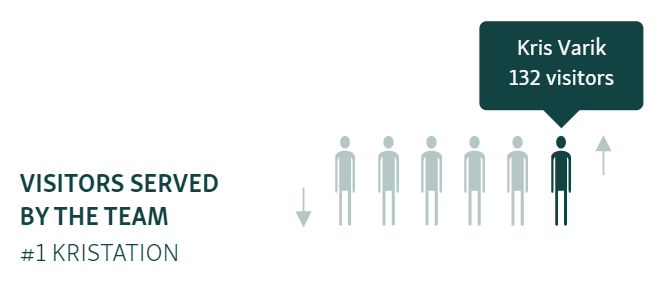Queue management systems are not only tools for managing waiting lines and customers. They can also help businesses address and improve employee productivity by streamlining staffing and scheduling processes.
We are speaking from experience. Our queue management system, Qminder, has helped countless businesses make more informed, hard-hitting decisions on how to better manage both their customers and staff.
Impact of a queue management system on employee’s KPIs
Key performance indicators, or KPIs, are used to evaluate the performance of a given employee.
These benchmarks help businesses make accurate decisions when it comes to salary, bonus packages, training programs, promotions and terminations.
If an employee falls behind by failing to maintain the average wait and service time, it is clear that something was lacking in their onboarding process.
Thus, a queue management system has a positive effect on employee performance.
Key performance indicators to take into account
There are several specific KPIs that a queuing system can help measure and evaluate.
The average number of customers served
This is a standard KPI for any support agent, which measures the amount of customers served by an agent over a specified period of time.
This helps assess the output and productivity of individual employees.
The average waiting time
This KPI measures the time it takes for an average visitor until they receive service.
The average service time
This KPI measures service delivery time. It is important for any business to know if there are any delays in service delivery which could negatively affect their perception.
Improving employee KPIs with a queuing system
Now, how can a queue management system help with improving key performance indicators?
Enter the Qminder’s User Details page.

User Details is an invaluable tool not only for location managers but also clerks themselves that lets users compare themselves to the rest of the team.
It breaks down each user’s performance and shows how many visitors the employee has interacted with. These visitors are then divided into three categories:
Served: visitors showed up during their turn and received service.
No shows: visitors were called to the desk but failed to show up in time.
Cancelled: visitors removed from the waitlist.

There is also a way to see, at a glance, how this specific user stacks up to their colleagues. The farther to the right the highlighted figure is, the higher the number of served customers.
With this, there is no need to calculate and compare the numbers by hand. One brief look is all you need to get the gist of the service situation.

The performance is given over time: both the number of visitors and the average service time are illustrated.
The data changes dynamically according to the chosen time range:
All time.
Previous week.
Custom time period.
How Qminder helps with staffing and scheduling decisions
Qminder provides me with the necessary data to support my staffing decisions, predict busy periods and increase efficiency in all stores. — Leon Tates, Regional Director, Carrier Enterprise
As we’ve outlined above, one of the main benefits of the Qminder queue management system is that it gives a clear overview of how employees are performing — both collectively and individually.
Using this data, location managers can assign individual employees to specific tasks, based on merit alone.
Another useful data point worth looking at is peak hours.
Thanks to peak hours, you can easily figure out which days and even hours require your workforce’s attention.
For example, if you see that during the days prior to holidays your store experiences more traffic, you can anticipate the next such occasion and expand your staff.
Read more: How to Train Service Staff for Peak Hours
On the employees’ end, a queue management system is beneficial in the way it empowers staff.
By offering the mechanisms to deal with queues more efficiently, queuing software gives service agents a chance to focus on serving customers rather than performing queue management tasks.
With this, the staff is likely to feel more productive and fulfill their job duties effectively. In a certain way, it helps create a sense of pride and fulfillment as employees are not distracted from their actual responsibilities.
Helping you deal more effectively with staffing, scheduling and queuing matters, Qminder is a powerful tool that supercharges your business success.
The decisions you take, no matter how small, must always be backed by data and hard numbers. Qminder provides you with exactly that — accurate data about the staffing and scheduling needs that your business experiences.
See for yourself. We offer a 14-day free trial of Qminder that you can sign up for right now.





![Free Sign-Up & Sign-In Sheet Templates [PDF]](/static/img/cms-blog/44LPc9KSvoVha1N3Sh9FGc/improve-waiting-room-checklist.png)
